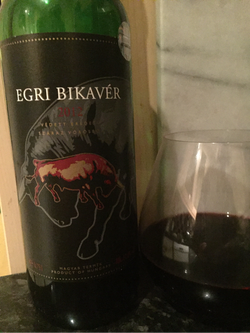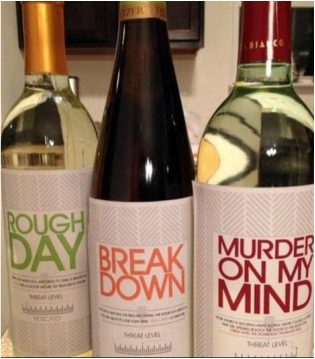
Looking at the label, and with the warning, I didn't expect this to be particularly special.
It's a funny name for a wine, "Bull's Blood". The wine was given the name due to a widespread belief that bull's blood was indeed a secret ingredient in the wine, giving the strength to defeat the invading Ottoman Turks back in 1522. In 1997, Hungary's first Districtus Hungaricus Controllatus - DHC was created (similar to the French Appellation d'Origine Controllée (AOC) for Eger and it's bull's blood wines.
It's a dignified and historic wine. However, I was unable to find out anything specific about this particular bottle except that it was vintage 2012. Usually Kardaka and/or Kekfrankos make up a big part of most Bikavér wines, but there was no blend information on the label - my Hungarian skills left me not even knowing what the brand/who the winemaker was.
What I could figure out was that it was a decent bottle. A beautiful smooth texture, medium to full bodied, with a lot of ripe tannin, smokey dark fruit flavours, a hint of violet and a lot of spice coming from oak. It tasted a lot better that I had given it credit for based on the label. I'd pictured a hasty 5€ purchase, that was perhaps okay for a Monday night wine. I'd fallen into the trap of judging a book by its cover, a wine by it's label. Many of us, with little else to go on, will choose our wine hastily because we "like the look" of it. And getting the branding right to appeal to the market is an art. I've seen some hilarious mistakes, or is it genius - you decide. See below. I'd love to hear about your wine successes and failures based on "buying on the label".
|
Back to our wine... Egri Bikavér must contain at least three of the following 13 grapes: Kadarka, Kékfrankos, Blauer Portugieser (Kékoportó), Cabernet Sauvignon, Cabernet Franc, Merlot, Menoire, Pinot noir, Syrah, Turán, Bíborkadarka and the modern Austrian crossings, Blauburger and Zweigelt. Grapes are usually vinified separately with blends receiving 6 months oak barrel ageing and 6 months in bottle before release. The "Superior" level Bikavér must contain 5 varietals and has twice as long in oak and bottle before release. It's complicated. |
|
In a world where grape varieties are becoming short hand for brands, is tough to communicate about wines like this. Consistency is another challenge with so many varietals to choose from. But there are big brand blends out there, and blending based on vintage and local conditions, is a long understood tradition in many top quality areas, like Bordeaux.
While Bull's Blood was once a huge success in the UK it's actually not that easy to get hold of now, outside of specialist retailers such as the Hungarian Wine Society and the Hungarian Wine House. In fact, even specialist wine merchants often only have the delicious sweet Tokaji wines in stock, while supermarkets may not even have that.
Perhaps because it's a hard wine to understand with so much possible variation, perhaps because of the success of New World wines since the 1980s, perhaps it was just seen as too 1970s.
It's a pity as its a wine with great character, a cool back story and at a reasonable price point.
If you do see Bull's Blood, make sure it's Eger (Egri) to get the authentic experience. Fans of spicy, dry reds should enjoy it. Why not visit Budapest and try some there?
Cheers! Egészségedre! (As they say in Hungary - it sounds a little like eggysheggydray)
PS - I'd love to hear your good and bad experiences of buying wine based on the label - feel free to email me, or contact me via my Facebook or Twitter.



 RSS Feed
RSS Feed
